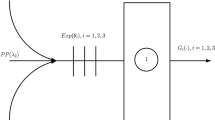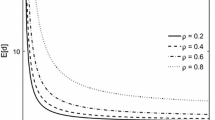Abstract
We analyze a discrete-time queueing model where two types of customers, each having their own dedicated server, are accommodated in one single FCFS queue. Service times are deterministically equal to \(s \ge 1\) time slots each. New customers enter the system according to a general independent arrival process, but the types of consecutive customers may be nonindependent. As a result, arriving customers may (or may not) have the tendency to cluster according to their types, which may lead to more (or less) blocking of one type by the opposite type. The paper reveals the impact of this blocking phenomenon on the achievable throughput, the (average) system content, the (average) customer delay and the (average) unfinished work. The paper extends the results of earlier work where either the service times were assumed to be constant and equal to 1 slot each, or the customers all belonged to the same class. Our results show that, in case of Poisson arrivals, for given traffic intensity, the system-content distribution is insensitive to the length (s) of the service times, but the (mean) delay and the (mean) unfinished work in the system are not. In case of bursty arrivals, we find that all the performance measures are affected by the length (s) of the service times, for given traffic intensity.










Similar content being viewed by others
References
Beekhuizen P, Resing J (2009) Performance analysis of small non-uniform packet switches. Perform Eval 66:640–659
Bruneel H, Kim BG (1993) Discrete-time models for communication systems including ATM. Kluwer Academic, Boston
Bruneel H, Melange W, Steyaert B, Claeys D, Walraevens J (2012) A two-class discrete-time queueing model with two dedicated servers and global FCFS service discipline. Eur J Oper Res 223(1):123–132
Bruneel H, Wuyts I (1994) Analysis of discrete-time multiserver queuing models with constant service times. Oper Res Lett 15(5):231–236
Fiems D, Bruneel H (2002) A note on the discretization of Little’s result. Oper Res Lett 30:17–18
Gao P, Wittevrongel S, Walraevens J, Moeneclaey M, Bruneel H (2009) Calculation of delay characteristics for multiserver queues with constant service times. Eur J Oper Res 199(1):170–175
Gonzáles MO (1992) Classical complex analysis. Marcel Dekker, New York
Karol M, Hluchyj M, Morgan S (1987) Input versus output queueing on a space-division packet switch. IEEE Trans Commun 35:1347–1356
Kleinrock L (1975) Queueing systems, part I. Wiley, New York
Laevens K (1999) A processor-sharing model for input-buffered ATM-switches in a correlated traffic environment. Microprocess Microsyst 22:589–596
Liew S (1994) Performance of various input-buffered and output-buffered ATM switch design principles under bursty traffic: simulation study. IEEE Trans Commun 42:1371–1379
Ngoduy D (2006) Derivation of continuum traffic model for weaving sections on freeways. Transportmetrica 2:199–222
Nishi R, Miki H, Tomoeda A, Nishinari K (2009) Achievement of alternative configurations of vehicles on multiple lanes. Phys Rev E 79:066119
Stolyar AL (2004) MaxWeight scheduling in a generalized switch: state space collapse and workload minimization in heavy traffic. Ann Appl Prob 14:1–53
Van Woensel T, Vandaele N (2006) Empirical validation of a queueing approach to uninterrupted traffic flows. 4OR Q J Oper Res 4:59–72
Van Woensel T, Vandaele N (2007) Modeling traffic flows with queueing models: a review. Asia-Pacific J Oper Res 24:435–461
Author information
Authors and Affiliations
Corresponding author
Rights and permissions
About this article
Cite this article
Bruneel, H., Mélange, W., Claeys, D. et al. A two-class global FCFS discrete-time queueing model with arbitrary-length constant service times. TOP 25, 164–178 (2017). https://doi.org/10.1007/s11750-016-0427-y
Received:
Accepted:
Published:
Issue Date:
DOI: https://doi.org/10.1007/s11750-016-0427-y




